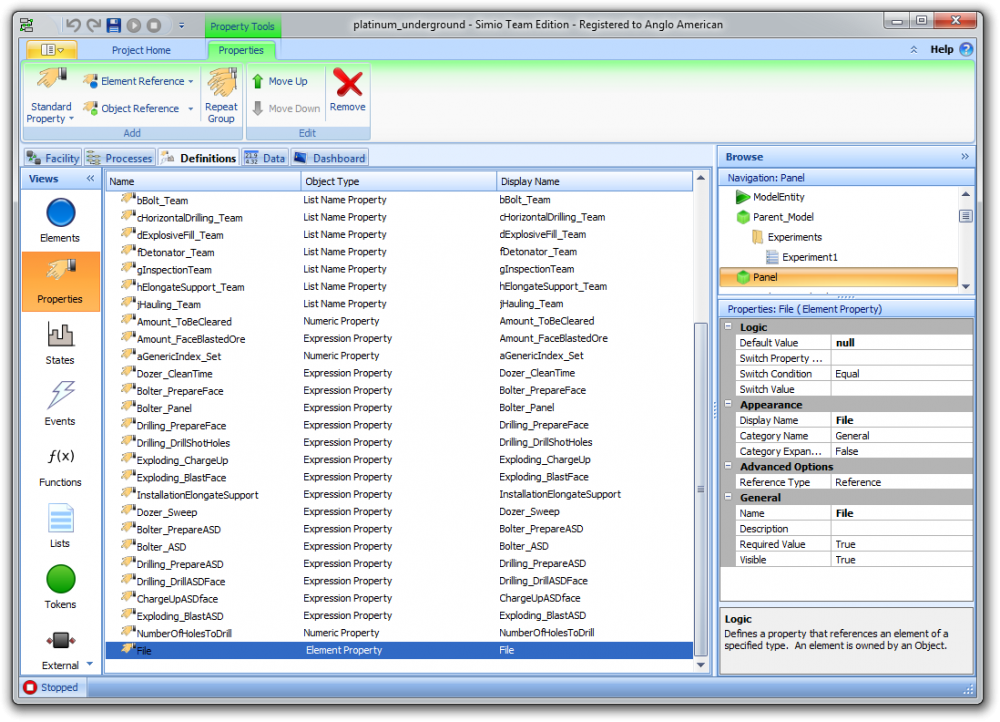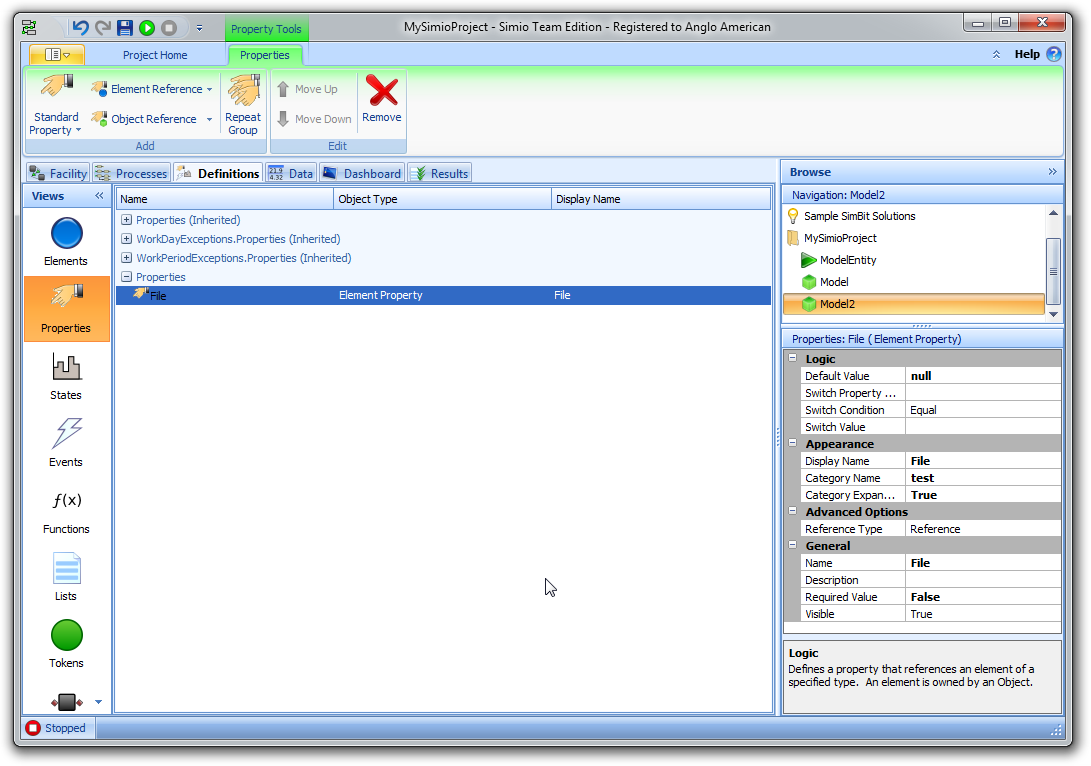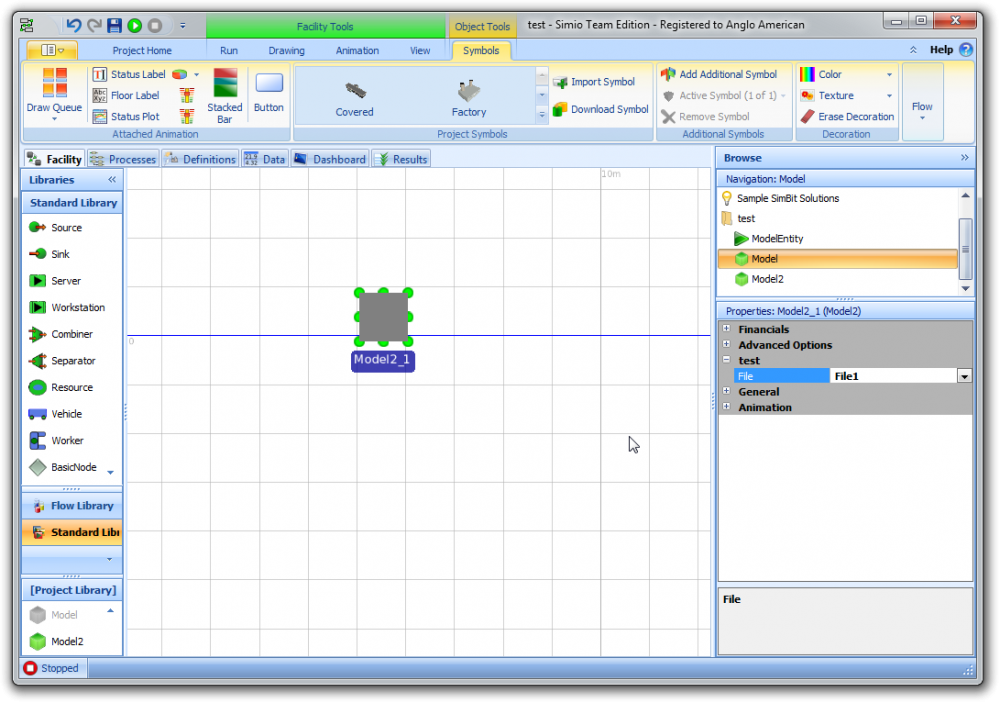Search the Community
Showing results for 'write csv'.
-
Hi, we would like to write the results of mutiple replications in one excel file (row=run.replicationNumber). We tried to change the excel connect and excel write step but we didn't find a solutuion. Do you have any suggestions for us in order to solve this problem? Best reg. Markus Gragert
-
Nadine - Within Simio Enterprise edition, model or entity state information can be written to a table during the simulation run. Within all Simio editions, we have various Write steps that you can use within a Process to write specific entity or model information to either a *.csv file, Excel file or database. The UserDefined panel of steps can be found in the Processes window and includes DbWrite and other related database steps, ExcelWrite and other related excel steps and Write step.
-
I almost always simulate this using fillers/extractors from the extended flow library rather than directly filling a container on a vehicle/entity. It sounds like you could do this with entities or vehicles as long as your decision making for entities is as simple as you describe. If you do it with entities, you will have to write a bit of decision logic to the entity. I would recommend doing this on the 'onVisitNode' process, which would basically be a decision of 'Should I park now?'... true being to park and then wait for some event (wake him up), false being to keep on towards the destination. If you do it with vehicles, you will need to make some sort of decision request for the vehicle to go to the relevant node for pick-up. Normally this is done by an entity at a transfer node using the 'ride' step. However, riding a vehicle is about transferring into the ride station, not filling a container.... I foresee many pitfalls with this methodology! I might have time to take a crack at this later -- no promises though.
-
If its a table import, you can change the column type to be 'object' instead of 'string' once the table is initially set up -- it will remember this type on future imports. It might be possible to write a custom step that finds an object based on a string, too, if the search step doesn't work for you.
-
Good point...We will make an adjustment for the Excel Write and DB Write steps to handle expressions. This way it work work the same way as the Write (text) step.
-
I've created a tool which makes my life a bit easier when trying to code Design Add-Ins for Simio and I thought that I would share it with everyone else. Disclaimer: I'm an engineer that is mostly self-taught when it comes to programming so it may not work (all I know is that it works on my pc ). Also I know that it isn't the prettiest piece of software either. What the tool does is allow you to try c# code directly within Simio and evaluate the results. If you have ever used a dynamic programming language like Matlab or Mathematica then it will be familiar to you. Its like the command window in Matlab where you can enter commands without compiling. Its called a REPL (Read-Eval-Print-Loop). more info here: http://en.wikipedia.org/wiki/Read%E2%80%93eval%E2%80%93print_loop The code uses the Microsoft Roslyn Compiler API. more info here: http://en.wikipedia.org/wiki/Microsoft_Roslyn If you want to play around with the source code then you will probably need to install the Roslyn CTP. Download here: http://msdn.microsoft.com/en-gb/roslyn. I created the solution using Visual Studio 2012 and I believe that the roslyn compiler only works with VS 2012 at the moment. How to install: 1) Copy the SimioREPL folder from the zip file into either: C:\Program Files\Simio\UserExtensions or c:\Program Files (x86)\Simio\UserExtensions 2) The folder structure should be ..\Simio\UserExtensions\SimioREPL How to get started: 1) Create a new model in simio. 2) Select SimioREPL from the Select Add-In drop Menu (Project Home Ribbon) 3) Click "Insert Initializing Code" button. This inserts some code to get the whole thing going. You may need to change the directory of the dlls loaded if you are not using a 64-bit machine (delete the x86 part from the path). 4) Press the Execute button to evaluate the code. 5) You can now start playing with the interactive coding environment The bottom textbox displays the results from each execution loop. If no return values are given then it will display just the execution count. How to use (here is an example of how to use the tool): Enter c# code just like in a normal program, for example: int x = 10; You can find out the current value of a variable by entering its name without the ending semi-colon, for example: x or x*2 + 10 -3 This will display the value in the output text box at the bottom of the window. I've added the ability to use Write() and WriteLine(), just like in a console application. for example: WriteLine(object.ObjectName); If the code is invalid then the Exception message will be displayed in the results text box, and the input code will remain. If the code is valid then the input code is cleared. The context object is already defined. Use context as you normally would. Some example code Walkthrough: Add some objects to the model IIntelligentObjects intelligentObjects = context.ActiveModel.Facility.IntelligentObjects; IFixedObject sourceObject = intelligentObjects.CreateObject("Source", new FacilityLocation(-5, 0, -5)) as IFixedObject; IFixedObject serverObject = intelligentObjects.CreateObject("Server", new FacilityLocation(0, 0, 0)) as IFixedObject; IFixedObject sinkObject = intelligentObjects.CreateObject("Sink", new FacilityLocation(5, 0, 5)) as IFixedObject; ILinkObject path1 = intelligentObjects.CreateLink("Path",sourceObject.Nodes[0],serverObject.Nodes[0],null) as ILinkObject; ILinkObject path2 = intelligentObjects.CreateLink("Path",serverObject.Nodes[1],sinkObject.Nodes[0],null) as ILinkObject; [Execute] Move the source object intelligentObjects["Source1"].Location = new FacilityLocation(-4.5, 0, -2); [Execute] List all the nodes on the server object foreach(var node in serverObject.Nodes) { WriteLine(node); } [Execute] List all the objects in the model foreach(var ob in intelligentObjects) { WriteLine(ob.ObjectName); } [Execute] ---------- Hopefully you find this useful. If you improve the tool using the Source Code given then could you please repost the source code here in this forum topic. I'm sure that there are many things that can be improved by a proper programmer. What it really needs is intellisense . SimioREPL Source.zip SimioREPL UserExtension.zip
-
I have not looked too deeply at this specific problem for a while (there may be some obvious gotchas I have forgotten), however... have you looked at the Write step, and the bind excel sheet to table? You can bind excel sheets to tables, which will solve the feeding problem, and you can write out to csv files and use macros in the main spreadsheet to suck in that data. I have gone off excel sheet DRIVEN models though. The capability within Simio was just not there in making it easier for users. It is painful having to explain to end-users of models that they need to fix the absolute path references to the sheets... and that they must manually import the data into the tables if it caches incorrectly... etc. I only use excel for examining the results now, and for the rest I use experiments via the API and a written custom application.
-
I remember in previous models being able to put a property on a model, in which I could reference a file from a higher level model. Is this possible? I am looking and can't see a file property. I want to be able to write out to a file that is defined in a top level model. Attached is a screenshot of the current element property selections. Also attached is a picture from an old model where I had successfully implemented the file element... but it looks weird now. I then copied that element into a new model and it works. (Screenshots attached) Was this functionality removed, or was I just a genius for one day in figuring out how to do that? Model attached for reference. EDIT: I attached the pictures in wrong order, so look at the pics starting from the bottom, and read the comments. test.spfx
-
I'd try creating the file element from within a write step in the lower level object using "Create New". Once it is created, place your object on screen then enter your file name in the newly added property. All the best,
-
This is something I have heard others talk about, but never actually got working for myself. Is it possible to reference a file with a dynamic name? I want to write out to a csv file during simulation runs, but the write originates from a submodel. This means that it is called multiple times, meaning that only one of my sub models actually gets to write. What is the easiest way to over come this? And yes, the write must originate from the sub-model.
-
Simio is a simulation modeling framework based on intelligent objects. The intelligent objects are built by modelers and then may be reused in multiple modeling projects. Objects can be stored in libraries and easily shared. A beginning modeler may prefer to use pre-built objects from libraries; however the system is designed to make it easy for even beginning modelers to build their own intelligent objects for use in building hierarchical models. An object might be a machine, robot, airplane, customer, doctor, tank, bus, ship, or any other thing that you might encounter in your system. A model is built by combining objects that represent the physical components of the system. A Simio model looks like the real system. The model logic and animation is built as a single step. An object may be animated to reflect the changing state of the object. For example a forklift truck raises and lowers its lift, a robot opens and closes its gripper, and a battle tank turns its turret. The animated model provides a moving picture of the system in operation. Objects are built using the concepts of object orientation. However unlike other object oriented simulation systems, the process of building an object is very simple and completely graphical. There is no need to write programming code to create new objects. The activity of building an object in Simio is identical to the activity of building a model – in fact there is no difference between an object and a model. This concept is referred to as the equivalence principle and is central to the design of Simio. Whenever you build a model it is by definition an object that can be instantiated into another model. For example, if you combine two machines and a robot into a model of a work cell, the work cell model is itself an object that can then be instantiated any number of times into other models. The work cell is an object just like the machines and robot are objects. In Simio there is no way to separate the idea of building a model from the concept of building an object. Every model that is built in Simio is automatically a building block that can be used in building higher level models.






